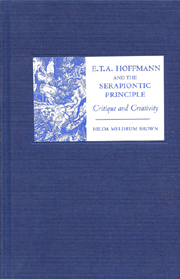Preface
Published online by Cambridge University Press: 05 February 2013
Summary
This study offers a new angle on the works of the great Romantic writer, composer, and eminent judge, E. T. A. Hoffmann. Hoffmann's status — especially in the Anglo-Saxon world — has been overdetermined by images emanating from such sources as operetta and ballet. He has been regarded mainly as a quaint eccentric with a penchant for paranoid “gothic” characters and spooky, sensationalist scenarios. Conversely, in his native country Hoffmann has been hailed as a leading practitioner of postmodernist theory. The writers of numerous highly technical monographs have strayed ever further away from their starting point in his fiction and failed to demonstrate his breadth and skill as a writer and thinker.
By focusing attention on the collection entitled Die Serapionsbrüder I have two aims in mind: first, I wish to demonstrate the coherence and consistency with which Hoffmann puts forward a series of interconnected ideas about the creative process and its reception that add up to a highly individual, if unorthodox, “Poetics.” It is amazing to find how dismissive (or blind) many commentators have been about this important aspect of Hoffmann's oeuvre and how this lack of awareness has often distorted readings of the Tales. Hoffmann was a leading spirit in German Romanticism, which, as a powerful literary movement, was unique within the European context for its close connection to contemporary philosophical ideas, and which strongly influenced English literature (for example, Coleridge).
- Type
- Chapter
- Information
- E. T. A. Hoffmann and the Serapiontic PrincipleCritique and Creativity, pp. ix - xPublisher: Boydell & BrewerPrint publication year: 2006

